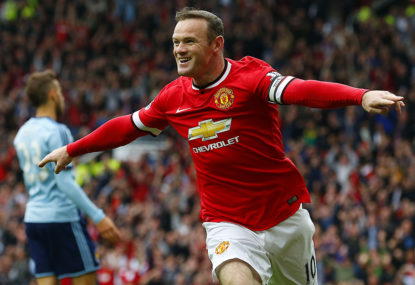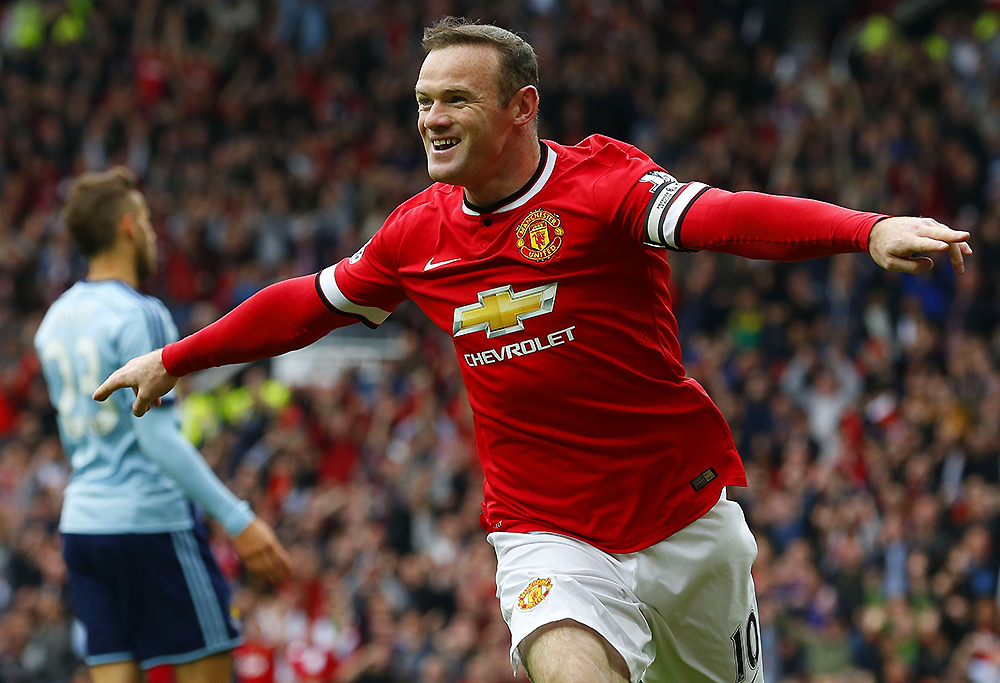Controversy as Villa keeper handed second yellow for shootout crowd taunting... but isn't sent off
Emi Martinez was saved by a new rule that resets yellow cards at the end of extra time, meaning his second yellow for taunting…

How will England’s once ‘Great White Hope’ be remembered?
I’m here to announce that Wayne Rooney is pretty good at football. And not only good, but arguably the finest England’s ever produced. Loved and loathed by so many, and in years to come will be remembered for just how good he was.
Some may disagree, hate the opinion, but we’re forced to accept it, as it’s objectively correct.
In his early days, Wayne Rooney was a breath of fresh air on English football. A continental-like forward, that was somehow born in the town of Croxteth, Liverpool. A new hope, the hope of a nation.
A pitbull in his endeavour for the ball: instinctive, primal and often explosive in results. The mid-career Rooney, one perfect third of the Ronaldo-Rooney-Tevez triumvirate, was something different and just pure joy. The ball, slowed and dipped and did wonderful things, fired into the back of the net at pace and angles that seemed impossible.
Rooney had the knack known only to the very best – the Messis, the Maradonas, the Ronaldos – where the ball always bounced for them.
And now, as is evident, Wayne Rooney is on his descent. Shuffling around the pitch like a lost delivery driver, very occasionally pinging an inch-perfect pass or free kick, but mainly just shouting loudly and flecks of spit catching the light in the cold night air.
There are still those moments of pure magic – a touch, stops it dead, then pings a pass out to a teammate and goes, going like a man trying to chase down a bus, like his limbs are trying to run a marathon. Howeer his body is desperately trying not to explode – and you catch a glimpse of what he was, what he always was and then worked even more to be: an absolute world-class player.
But then he also trampled on Richard Carvalho’s balls once and lost his head. So you can see the many depths and contrasts to the man.

(AP Photo/Matt Dunham)
The problem with English fans is that they’re too close to artistry to truly see it. In this analogy, and stick with me, English fans are the art critics and Wayne Rooney the art. Wayne Rooney is the Whistler’s Mother, or something of the like. Instead, he is that adaptation your mate’s girlfriend has drawn, a little bit shit, large freckled forehead, oversized ears and probably a bit pudgy, but art nonetheless, and English fans, the art critics, turn their noses up to it.
That’s sort of where most English fans are at with Rooney – who is still at Manchester United, still chugging away at the very top-level, and making a bloody healthy living as footballer.
It won’t be for another decade or so that English fans will begin to appreciate him for what he was. It’ll be long after next season’s inevitable stint in China or the States, a couple of flat campaigns out there, wherever he lands, a shit-load of cash to sit up-top, spray a few passes and put a few sitters wide.
But then maybe he goes on a little run of form, bangs five past Shandong Luneng, and the year is 2021 and England are sputtering their way through the end of a World Cup qualifying campaign, and there’s chat – not rumours, actual chat – of maligned English boss Gary Neville bringing his old mate Rooney back into the the national team set-up.
And he scores, a deflected goal, in a must-win 1-0 against Slovakia. Then he calls it, pulls the pin on his career, knees knackered, at 36. He disappears from the public eye for a bit before he reappears, hair shaved off, sitting on the panel in a white-shirt-navy-suit combo discussing United’s mid-week battle away to Stoke City.
And it will be then when English fans begin to appreciate.

(AFP PHOTO/LINDSEY PARNABY)
There will be the next Young English Hope – a lad named John Berthwick-Cook, or something, 16 years old, born in 2009, scoring a double on his debut.
Wayne Rooney, John Terry, and Charlie Adams for some reason, all have a laugh on couch, and one of them says: “He’s a bit like you in your younger days, Waz, what you reckon?”
Wayne mumbles, runs his right hand against his head, as if momentarily forgetting he doesn’t have hair anymore, and replies “Yeah, well you know, obviously it’s early days, but he’s a top lad, a good boy from a nice family – we’re all well excited about him, you know – so yeah.”
A highlights package will then run of Wayne Rooney’s career – and English fans will be sat there watching this via hologram, because we’ll probably have them by then, and then Wayne Rooney will pop up, mid-air, in your lounge room, and fire home an audacious, first time volley, top bins against Newcastle United – and that’s when it will hit. When everyone will take a collective deep breath and say.
Shit. Wayne Rooney was really bloody good at football!
But, for now, they’re too close to know it.
—
The Wayne Rooney story goes like this. A 16-year-old school kid bursts onto the scene as ‘Everton’s / England’s Great White Hope’ and within the space of a month, made his debut against Spurs at the start of the 2002-03 season.
He then scored a double in the league cup, before belting the ball past David Seaman and broke Arsenal’s 30-match unbeaten run, and then, bang! We all knew about him.
Rooney once appeared raw, unpolished and also brilliant, a common theme throughout his career. So heavily scrutinised, that a lot of the chat about Rooney being a legend seems to hinge on the fact that he appears both brilliant and a little bit rubbish at the same time.
A couple seasons at Everton, an England debut against Australia, and a decent tournament at Euros 2004, inevitably meant Rooney was ready for the next step-up. He eventually moved to United for £25 million at just 18 – where he’s been grafting away, ever since.
Many talk about whether Rooney has or hasn’t filled his potential as a player, as if winning every possible club competition and being United’s and England’s greatest ever goalscorer is somehow falling short.
His United career has featured it all – five Premier league titles, one FA Cup, three League Cups, one Champions League, one Europa League and one Club World Cup. If it counts, he’s also got red cards, injuries, goal droughts, transfer requests, captaincy – and that bizarre cruciate injury he coped against Bayern Munich in 2010.
Rooney did a number on his ankle in the quarter final, putting his World Cup in doubt, but then, oddly, turned up for the second leg the following week.
This is Rooney: at his peak, a player linked to big-money moves – an English player you could actually imagine playing in Spain or Italy – but struggled with poor fitness. And because he is Wayne Rooney and because he loved to play, he’d go the rest of the season without scoring, culminating in a rubbish World Cup in South Africa.
But then he scored 27 goals the following season, led United to the title and Champions League final.
So what the hell do I know?
Nothing about Rooney makes sense. Many see Rooney as the last throwback to an era where kids actually liked playing football – but this tag seems to belie something else, something that makes him a hero and villain to English supporters and pundits, who love to build him up as much as bring him down.
He is a cult figure. The most brilliant English player, who has not lost touch of his working-class roots. He is, still, just a timid lad from Croxteth who has banged in more goals for Manchester United than anyone, has scored more goals for England than anyone and stood on Ricardo Carvalho’s balls once.
This is what makes Rooney so fascinating; the depth and contrasts in his highlights reel, from pure madness to pure magic, and in the middle there’s Rooney, blowing up at the referee, glowing pink in the middle of the pitch, scoring a worldy in the Champions League final, and earning £300k a week for it.
Then there was that moment – ‘The Overhead Kick against City’ (arguably via his shin). It was a make-or-break February title four-pointer, match poised at 1-1; you just know you’ve got the classic, United late goal.
And then Rooney is backwards, mid-air from nowhere, and Nani has floated one in from the right-side of the pitch, and boom. Pinging in off his shin, and that was it: Rooney’s goal, Rooney’s moment, three huge title points towards Fergie’s penultimate title, and Old Trafford goes barmy.
These are moments Rooney was made for. A headline writers dream.
Now, he is slowly blunting from the knife-sharp one-man attacking Great White Hope into a sort of symbol to Adidas and Nike, a statue in a tracksuit that sometimes shouts obscenities directly at the referee.
A beefy Icarus who flew too close to the sun and tried to touch the hem of greatness, but instead fell just short, scored bunch of goals for club and country, won every club trophy on offer, threatened to leave a few times, and crunched Roberto Cavalho in the balls.
So let’s enjoy the long goodbye. Enjoy watching Rooney slowly trot around the pitch, knackered – in China, the USA, the UK or wherever it may be – for a few more years to come for what is: the fading sparks of an icon, the likes of which we’ll never see again. And one we won’t truly appreciate for a while yet.